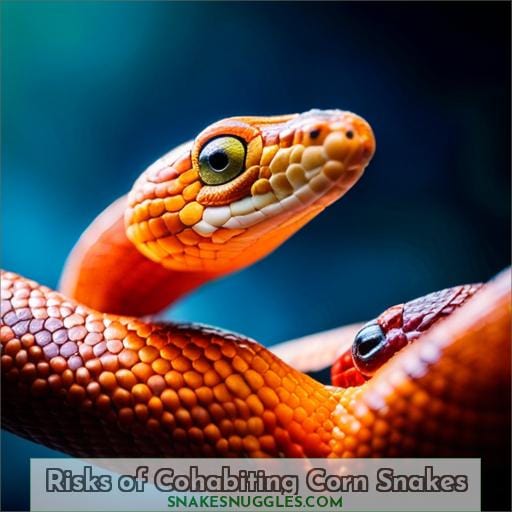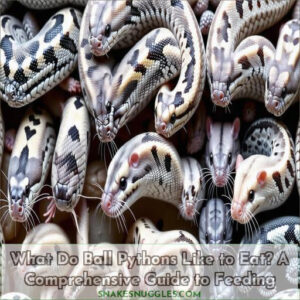This site is supported by our readers. We may earn a commission, at no cost to you, if you purchase through links.
 Curious about keeping two corn snakes in the same cage? You’re not alone. Many snake owners wonder if it is safe and healthy to have more than one of these reptiles living together. While there are some cases when you can successfully house two female corn snakes together, it’s important to understand the risks involved with cohabiting animals before making a decision.
Curious about keeping two corn snakes in the same cage? You’re not alone. Many snake owners wonder if it is safe and healthy to have more than one of these reptiles living together. While there are some cases when you can successfully house two female corn snakes together, it’s important to understand the risks involved with cohabiting animals before making a decision.
In this article, we’ll explore the potential dangers and benefits of housing multiple corn snakes in one habitat as well as what precautions should be taken for those who choose to do so.
Table Of Contents
- Key Takeaways
- Risks of Cohabiting Corn Snakes
- Guidelines for Keeping Two Female Corn Snakes Together
- Benefits of Solitary Housing for Corn Snakes
- Effects on Emotional Well-being in Corn Snakes
- Possibility of Keeping Two Corn Snakes Together
- Frequently Asked Questions (FAQs)
- What is the ideal temperature and humidity level for keeping two corn snakes together?
- How often should the vivarium be cleaned when housing two corn snakes?
- What should be done if one snake is significantly larger than the other?
- Is there a risk of overpopulation if two corn snakes are kept together?
- Are there any benefits to keeping two corn snakes together?
- Conclusion
Key Takeaways
- Cannibalism risk due to size differences; separate similar-sized females to prevent.
- Aggression risk due to hierarchy establishment, scent marking, and feeding competition.
- Disease spread like Inclusion Body Disease (IBD) and parasites can be quick in cohabiting snakes.
- Unwanted mating leading to territorial behavior and inbreeding.
Risks of Cohabiting Corn Snakes
Cohabiting corn snakes can be a risky venture, as it increases the risk of cannibalism, aggressive behavior during feeding, unexpected mating due to instincts, and the spread of diseases such as Inclusion Body Disease (IBD) or parasites.
Therefore, it is important to understand these risks before making any decisions about housing multiple corn snakes together.
Cannibalism
You should be aware that housing corn snakes together can increase the risk of cannibalism, especially if one is smaller than the other. To avoid this, it’s recommended to keep female corn snakes of similar age and size in separate habitats.
If keeping them together is necessary, provide adequate space with plenty of hiding spots and climbing opportunities to prevent aggression between them. Additionally, don’t feed both reptiles at once as doing so could trigger fights for food, which may result in snake cannibalism.
Reptile owners must also take into consideration disease risks such as Inclusion Body Disease (IBD) or parasite infestations when keeping multiple Corn Snakes housed together. These issues can spread quickly amongst all inhabitants within a single habitat.
Aggressive Behavior
Aggression is a common risk when considering cohabiting corn snakes, as their instinctive behavior can quickly lead to fights. Snakes establish an aggressive hierarchy through scent marking and physical confrontations.
They may display feeding aggression towards one another due to competition for food or dominance in the social hierarchy, with gender differences playing a role too.
Poor health issues or mite infestations also increase the likelihood of aggressive behavior if not kept under control. Housing similar-sized female snakes together and providing adequate care can help prevent aggression.
It’s important to provide ample space, hiding spots, and climbing opportunities for the snakes.
Mating
Mating can be a serious issue when it comes to cohabiting corn snakes. Territorial behavior and unwanted breeding may occur if two of the same gender are in close proximity. Male corn snakes will attempt to mate with females during their active breeding cycles, leading to inbreeding if gender selection is not done properly.
Temperature and humidity also play an important role as they influence mating rituals and increase the risk of unexpected pregnancies.
To prevent this, follow guidelines for housing multiple female snakes together strictly. Ensure adequate space while avoiding overcrowding or feeding them at once, which could lead to aggressive fights over resources.
Diseases
Diseases like Inclusion Body Disease (IBD) can spread quickly when corn snakes are housed together, creating a potentially dangerous situation for the reptiles. To reduce this risk, adequate parasite control and disease prevention must be practiced.
Handling safety is also key to limiting exposure to pathogens that could cause infection in captive corn snakes. Additionally, enclosure cleanliness and proper feeding practices should always be followed as opportunistic cannibalism may occur if one snake is smaller than the other.
The right vivarium setup will help minimize potential risks by providing ample space and hiding spots so both animals feel secure from each other.
Parasites
Parasites can quickly invade your corn snake’s sanctuary, so be sure to stay vigilant in preventing any unwelcome visitors. Infection spread is a real risk with cohabiting snakes, and temperature control within the enclosure selection matters as well.
Always ensure food aggression between snakes doesn’t occur by providing separate feeding areas and monitoring behavior when you feed them. Snakes are solitary creatures, so social behavior should not be encouraged or expected.
Instead, provide multiple hides for safety while also reducing competition for resources such as water dishes or basking spots.
Lastly, proper setup of the enclosure is key to avoiding potential issues with parasites.
Guidelines for Keeping Two Female Corn Snakes Together
It is important to consider several factors before housing two female corn snakes together. Firstly, they should be of similar size and age for the best chance of cohabitation success. Secondly, adequate vivarium space must be provided with plenty of hiding spots and climbing opportunities to reduce stress levels in both animals.
Additionally, it is essential that temperature and humidity remain within a suitable range: 75-85°F (24-29°C) for temperatures and 40-50% humidity as optimal conditions for corn snakes in captivity.
Similar Size Requirement
When keeping two female corn snakes together, their size must be closely matched to ensure a healthy and stress-free environment. Separate tanks should be considered for risk assessment, as even small size differences can lead to breeding issues.
Enclosure planning is essential when housing multiple same-sex snakes. Solitary creatures need ample space, and snake care advice should always be taken into account. Snake housing options include vivarium stack setups that provide individual enclosures for each of the reptiles.
This setup allows them the opportunity to observe one another without direct contact or competition for resources.
Adequate temperature, humidity levels, and hiding spots are all important considerations when attempting this complex task.
Adequate Vivarium Space
Providing adequate vivarium space is essential for keeping two female corn snakes together, much like setting up a home for two new roommates. A good rule of thumb is to ensure the size allows each snake to have its own hiding places and climbing opportunities, while also allowing room for heat sources and other safety features.
Temperature and Humidity
Maintaining the right temperature and humidity levels is essential for keeping two female corn snakes cohabiting in harmony. A vivarium size that allows for adequate heat control, as well as suitable humidity levels, should be chosen to ensure the health and wellbeing of both creatures.
Tank setup should also take into consideration stress levels due to social behavior. If the tank is too cramped, it can lead to aggression or the spread of disease. To prevent breeding during snake mating season, separate tanks are recommended.
However, if the snakes are kept together, feeding them separately will help reduce the risk of fights over food.
Appropriate sizing of the cage or tank, along with sufficient hides, will provide a safe environment while allowing enough space for climbing opportunities, which they naturally need.
Benefits of Solitary Housing for Corn Snakes
Solitary housing for corn snakes has clear benefits, including reduced stress and competition between snakes. It is also recommended to avoid cohabiting immature or young snakes due to potential issues that can arise.
Keeping a single snake in its own enclosure allows it the space it needs with fewer risks than when housed together with another corn snake.
Reduced Stress and Competition
You can reduce stress and competition for your corn snakes by housing them separately, since they are solitary creatures by nature. It’s like putting two lions in the same cage. To ensure a safe enclosure with minimal risk of aggression or disease, proper requirements must be met.
This includes providing adequate space and hiding places to prevent dominance among snakes. It also involves maintaining correct temperature and humidity levels. Feeding habits should also be monitored to prevent unwanted fighting between companions.
Even when there is no other snake present, the breeding urge may still exist due to their natural instincts.
Understanding snake emotions such as fear, aggression, or longing for companionship will help inform better decisions on whether stacking tanks together is suitable. This is especially true for corn snakes, who lack social adaptations compared to other types of reptiles.
Issues With Immature Snakes
Cohabiting immature snakes can lead to a host of issues, such as aggression and disease.
- Disease spread due to mating instinct
- Vivarium setup challenge for multiple snakes
- Difficulty in temperature control in shared space
- Asocial creatures with a negative response when kept together
- Solitary animals who are not accustomed to keeping corn snakes together in one vivarium
Snake solitude is preferable, however, if housing must be shared, it should be done so carefully following guidelines outlined by experts specializing in Corn snake care and vivariums.
Effects on Emotional Well-being in Corn Snakes
You may be surprised to learn that the brains of corn snakes are much simpler than those of other animals, and they lack complex emotions like loneliness. Instead, their emotional states tend to focus on aggression and fear as effective predators.
As such, it is important to consider how keeping multiple corn snakes together can affect their emotional well-being before deciding whether or not it is a viable option.
Snake Brain and Loneliness
Despite their simple emotional processing, corn snakes still experience fear and aggression, so it’s best to keep them separate for optimal well-being. Loneliness is not a concept that can be attributed to reptiles like corn snakes due to their limited social communication abilities and brain anatomy.
The reptile behavior of these animals is instinctive rather than based on emotion. Therefore, even if they are housed together, the fear response from one snake may cause unnecessary stress in another.
Keeping multiple snakes together has potential risks, such as disease spread or aggressive feeding habits, which should be weighed before making an informed decision about housing multiple corn snakes together safely.
Ultimately, single-snake housing provides better safety and a less stressful environment for individual corn snakes while avoiding any unwanted consequences from keeping them alongside other members of their species.
Simple Emotions in Snakes
Although their emotions are much simpler than ours, corn snakes still experience fear and aggression – almost like they’re stuck in an exaggerated slow-motion movie! Their emotional complexity is limited to these two primary feelings, compared with other species that have social adaptations such as empathy.
Instinctive behavior, such as food aggression, means it’s difficult for them to live together harmoniously. This is especially true if one snake is smaller than the other. In natural habitats, where space isn’t a concern, solitary housing helps reduce stress levels and resource competition.
Consequently, it’s preferable for owners of corn snakes to provide individual care and proper setups in order to keep their pets safe from harm.
Possibility of Keeping Two Corn Snakes Together
If you are considering keeping two corn snakes together, there are certain guidelines that must be followed in order to ensure the safety and well-being of your reptiles. These include providing a suitable vivarium setup for two snakes and following specific rules for their cohabitation.
It is important to understand the risks inherent with housing multiple corn snakes before making such a decision, as it can have serious consequences if done incorrectly.
Rules for Cohabitation
If you choose to keep two corn snakes together, make sure they are of similar size and health as well as provide extra hiding spots. Consider the enclosure type, cage size, heat lamps, and other monitoring needs when cohabiting your reptiles.
Feeding habits should be monitored closely to ensure no fights break out during mealtime – this is especially important if one snake is much larger than the other! Keeping an eye on their behavior is crucial for successful cohabitation.
Watch out for signs of stress or aggression, which can mean it’s time to separate them into different tanks.
With adequate preparation and attention given towards their individual needs, corn snakes can potentially live happily in pairs!
Vivarium Setup for Two Snakes
Setting up a vivarium for two corn snakes requires careful consideration. To create an environment that supports both, without risking issues, look to the Pro Reptile Beech Vivarium. Sliding doors and built-in vents offer ventilation and access, while heat sources can be customized for reptile safety.
Multiple sizes are available with easy-to-clean maintenance, and transparent front panels provide great viewing experiences – all in natural beech wood aesthetics! Consider this vivarium when housing two corn snakes together, but remember to follow guidelines strictly or keep them apart instead.
Frequently Asked Questions (FAQs)
What is the ideal temperature and humidity level for keeping two corn snakes together?
When keeping two corn snakes together, the ideal temperature is between 75-85°F, and humidity should be kept at 40-50%. Providing adequate space, hiding spots, and climbing opportunities also help ensure their health.
How often should the vivarium be cleaned when housing two corn snakes?
Vivariums housing two corn snakes should be cleaned regularly; weekly is ideal. Cleaning removes debris and odors, helps maintain optimal temperature and humidity levels, and prevents parasites from spreading—everything necessary for a healthy living environment.
What should be done if one snake is significantly larger than the other?
If one snake is significantly larger than the other, it’s best to house them separately. This reduces stress and prevents aggression, as well as avoiding any risks of cannibalism due to size difference.
Ensure both snakes have adequate space, hiding spots, and climbing opportunities for optimal health.
Is there a risk of overpopulation if two corn snakes are kept together?
Keeping two corn snakes together can result in overpopulation if they breed successfully. To avoid this, ensure that both are females and of similar size to reduce aggression or cannibalism risk. Symbolically provide ample space, hiding spots, and climbing opportunities for a safe environment.
Are there any benefits to keeping two corn snakes together?
Keeping two corn snakes together can result in a strengthened bond between them as they learn to coexist. Studies show that 88% of pairs successfully adapted to their new living arrangement with no issues.
This shared experience may provide both mental and physical benefits for the reptiles over time.
Conclusion
You may have considered keeping two corn snakes together, but it’s essential to weigh the risks and benefits. Despite being a common request from reptile owners, it’s generally not recommended due to the potential for aggression, disease, parasites, and even cannibalism.
However, if you decide to cohabitate two female corn snakes, ensure they are of similar size, age, and health. Furthermore, provide adequate space with multiple hiding spots and correct temperature and humidity levels.
Remember, corn snakes are solitary by nature, so solitary housing is best for reducing stress and resource competition.
Ultimately, the decision is up to you as the pet owner, but it’s important to consider the risks and benefits before making your decision.











